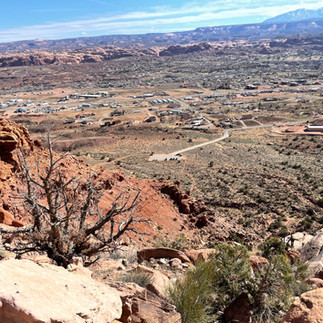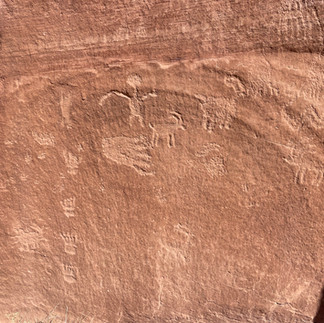The Rock Art of Hidden Valley
- wwambrose

- Mar 25, 2022
- 2 min read
Updated: Jun 23, 2023
North-south highway 191, which runs through Moab UT, is bordered to the west by red cliffs that extend for miles. On our last day in Moab we took a trail up and over the face of the cliff. On top was a magnificent valley that opened up and seemed to stretch for miles. Named Hidden Valley Trail, I kept calling it Happy Valley as the scenery was spectacular on this windy day -- wavering grasslands, traversing tumbleweeds, and enduring juniper trees. The hidden treasure was the ancient rock art at the end of the trail.

The beginning of the trail, to get over the cliff, was steep and rocky, and offered long-distance views of the highway and commotion below. Charlie raced up and down the precarious track with abandon.
Once over the edge of the cliffs, civilization disappeared. It felt like the wild west opening up. I could easily envision horseback riders meandering along the trail. According to VisitUtah, "the Hidden Valley Trail follows an ancient path used by Native Americans for the past two thousand years."
The trail and surrounding valley and cliffs are part of the Behind the Rocks Wilderness Study Area. Looking back from the end of the valley and the climb to the cliffs presented some of the best views with the snowy peaks in the distance.

When we reached the cliffs we were amazed by the amount of petroglyphs and their stunning stories. This is one of the most well known: a human figure inside another? Or swallowed by a large creature with horns? A new t-shirt design? According to the Bradshaw Foundation the circle may represent a shield with the lightly dotted torso depicted behind the shield as if x-rayed.

While pictographs are painted on the rock walls (see our post Junior Ranger for some we saw in Arizona), petroglyphs are carved in the soft sandstone. Most that we saw were over 2,000 years old, dating to the Archaic period (5,500 BC - 1 AD), with some carved by Anasazi (1 AD - 1250 AD) and some possibly by Ute (from 1200 AD). Many of the drawings depict scenes of the hunting, gathering culture: animals such as deer, elk and bighorn sheep; tracks behind a deer/elk and footprints of a bear; possibly antlers. The crown-like drawing, according to some sources, is probably a ceremonial headdress.
Our search for America, it turns out, is taking us back in time as well.








































Comments